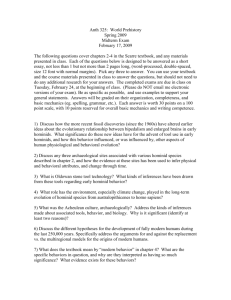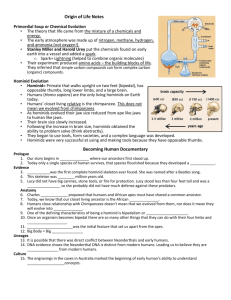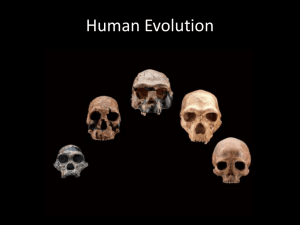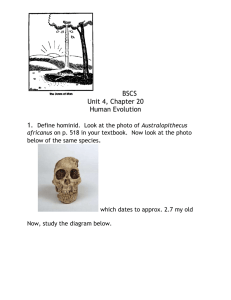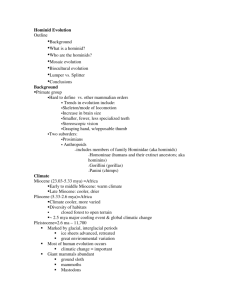Chapter 8 Hominid Origins
advertisement
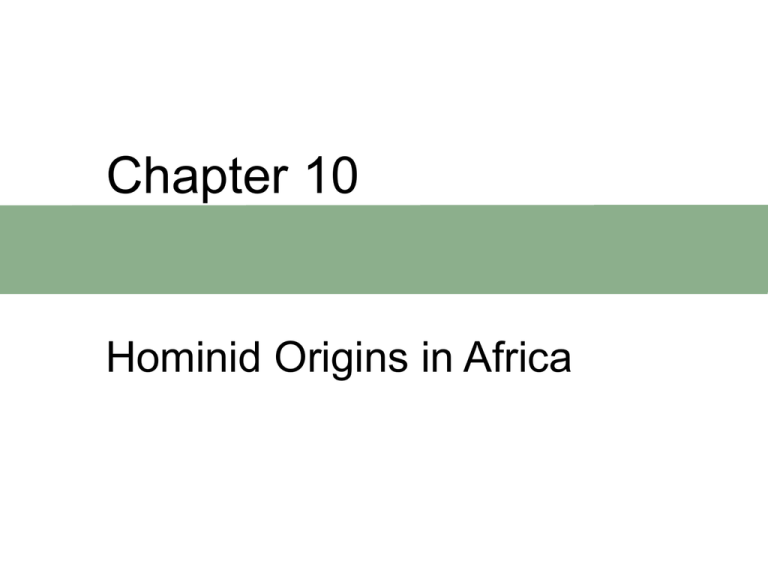
Chapter 10 Hominid Origins in Africa Chapter Outline Early Primate Evolution Miocene Fossil Hominoids The Bipedal Adaptation Early Hominids from Africa (PreAustralopithecus Finds) Australopithecus from East Africa Chapter Outline Early Homo South African Sites Interpretations: What Does It All Mean? Adaptive Patterns of Early African Hominids Early Primate Evolution Earliest fossils identifiable as hominids are from Africa. From new discoveries, the earliest hominids are now thought to date as far back as the end of the Miocene (7–5 m.y.a.). These discoveries have all been made very in the last five years. Eocene primates There are more than 200 species of Eocene primates found in North America and Europe. Some are probably ancestors of the prosimians, and others are probably related to the tarsier. New discoveries of late Eocene primates from North Africa, the Persian Gulf, and China, indicate anthropoid origins were well established by this time. Oligocene (34-23 m.y.a.) Anthropoid Remains Most come from the Fayum, in Egypt. The Fayum anthropoids include the genera Apidium and Aegyptopithecus. – Apidium was a squirrel-sized arboreal quadruped. – Aegyptopithecus is about the size of a howler monkey. It has a small brain and a long snout, and has no hominoid or Old World monkey derived features. Location of the Fayum, Oligocene Site in Egypt Inferred Paleobiological Aspects of Oligocene Primate Apidium 750–1,600 g Weight Range (2–3 lb) Aegyptopithecus 6,700 g (15 lb) Substratum Arboreal Arboreal Locomotion Quadruped Quadruped Fruit, seeds Fruit, some leaves? Diet Major Events in Early Primate Evolution Miocene Fossil Hominoids Continental drift during the Miocene altered climatic patterns and created new migration routes. The initial Miocene was warmer than the preceding Oligocene. The Arabian Plate “docked” with northeast Africa around 16 m.y.a., allowing African animals direct passage into southwest Asia. Miocene Hominoid Distribution, From Fossils Discovered Miocene Hominoids May be grouped geographically into African, European, and Asian forms. – The African forms (23-14 m.y.a) include the bestknown genus Proconsul from Kenya. – The European forms (16-11 m.y.a.) include a number of derived forms that are not well understood. – The Asian forms (16-7 m.y.a.) are the largest and most varied group. The best-known genus is Sivapithecus. Miocene Hominoids: 5 Generalizations 1. 2. 3. 4. 5. They are definitely hominoids. They are mostly large-bodied hominoids. Most are derived relative to living apes. Sivapithecus from Turkey and Pakistan has facial features similar to living orangutans. There are no fully documented, definite hominids among the Miocene material, although it now appears that hominids diverged in the latter Miocene. Hominid Bipedalism The pelvis is shaped more in the form of a basin to support internal organs; moreover, the ossa coxae are shorter and broader, thus stabilizing weight transmission. Hominid Bipedalism The foramen magnum is farther underneath the skull, so the head is more or less balanced on the spine and requires less robust neck muscles to hold the head upright. Hominid Bipedalism The spine has two distinctive curves—a backward (thoracic) one and a forward (lumbar) one—that keep the trunk (and weight) centered above the pelvis. Hominid Bipedalism Lower limbs are elongated, as shown by the proportional lengths of various body segments (e.g., in humans the thigh comprises 20% of body height, while in gorillas it comprises only 11%. Hominid Bipedalism The femur is angled inward, keeping keeping the legs more directly under the body; modified knee anatomy also permits full extension of this joint. Hominid Bipedalism The big toe is enlarged and brought in line with the other toes; in addition, a distinctive longitudinal arch forms, helping absorb shock and adding propulsive spring. Earliest Hominids – All are from Africa. – The earliest traces of hominid evolution were thought to date to between 3 and 4 million years ago in 1999, but the earliest traces may date to 7 million years ago. – A nearly complete cranium from TorosMenalla, Central Africa, was discovered in 2001 and has been assigned the name Sahelanthropus tchadensis. Sahelanthropus tchadensis • • • • The braincase is small but it has huge browridges combined with a sagittal crest and large muscle attachments in the rear. The face does not protrude, unlike other early hominids. There are no postcranial elements, so its locomotor capabilities are unknown. The hominid status of Sahelanthropus is insecure, and some have argued it is actually an ape. Discoveries from East Africa The Tugen Hills area is located near Lake Baringo, Kenya. – The fossils found here have been named Orrorin tugenensis and date to about 6 m.y.a. Fragmentary, late Miocene (5.8-5.2 m.y.a.) fossils discovered in 1997 through 2001 in the Middle Awash (Ethiopia) . – Remains consist of mostly teeth, a jaw fragment, and some pieces of the limbs (these have been assigned to Ardipithecus kadabba). Ardipithecus from Aramis Fossil remains of perhaps 50 individuals from Aramis (Ethiopia) were excavated between 1992 and 1995 and date to about 4.4 m.y.a. The remains provide anatomical evidence of bipedalism, the criterion for hominid status. The team of excavators have suggested that the Aramis hominids be assigned to a new genus and species, Ardipithecus ramidus. Australopithecus from East Africa East African fossil remains assigned to the genus Australopithecus date from 4.2 to 1.4 m.y.a. The earliest Australopithecus remains come from Allia Bay and Kanapoi (4.2-3.9 m.y.a.). The limb remains indicate bipedalis, and the molars have thick enamel caps. They retain primitive characteristics such as large canines and a sectorial lower first premolar. Laetoli Dated at between 3.5 and 3.7 m.y.a. Fossilized hominid footprints were found in an ancient volcanic bed. Despite agreement that these individuals were bipedal, some researchers feel they were not bipedal in the same way as modern humans. Hadar (Afar Triangle) Dating calibrations suggest a range of dates from 3.9 and 2.3 m.y.a. – "Lucy" an Australopithecus afarensis female, was recovered here. – Group of bones representing 13 individuals and including 4 infants, suggest a social unit died at the same time.. – Some stone tools may be 2.5 million years old, making them the oldest cultural evidence yet found. Bouri (Middle Awash) Several fossils were discovered dating to 2.5 m.y.a. These fossils are quite different from other Plio-Pleistocene hominids: – Projecting face – Very large back teeth – Long hind limbs Animal bones found with these fossils show clear signs of butchering. Australopithecines from Olduvai and Lake Turkana – Represent two different genera and up to six different species, later in time and more derived than A. afarensis. – The virtually complete cranium of the 2.5 m.y. old WT 17000 (Australopithecus aethiopicus) from West Lake Turkana is the earliest trace of the “robust” forms in East Africa. Olduvai Gorge Louis and Mary Leakey conducted continuous excavations from the 1930's to early 1980. Paleontological evidence includes more than 150 species of extinct animals which can provide clues to the ecological conditions of early hominid habitats. South African Sites The first australopithecine “the missing link” between apes and humans was discovered at a quarry at Tuang. As the number of discoveries accumulated, it became clear that the australopithecines were not simply aberrant apes. The acceptance of the australopithecines as hominids required revision of human evolutionary theory. “Robust” Australopithecines Similar to those found in East Africa. Small cranial capacities, large broad faces, and very large molars and premolars. Most researchers agree these hominids have distinctive enough dental proportions and facial architecture to be designated a separate species (A. robustus). All “robust” species are adapted to a diet of hard food items such as seeds and nuts. “Gracile” Australopithecines The “robust” lineage is present in both east and South Africa, but the “gracile” lineage (A. africanus) is only in South Africa. “Gracile” australopithecines are small-brained but not as large-toothed as the “robust” varieties. There seem to be no significant differences in body size between the “robust” and “gracile” varieties. Geology and Dating Problems in South Africa The South African hominid sites have complex geologic contexts. Hominid remains are found in limestone cliffs, caves, fissures, and sinkholes mixed with other fossils in blocks of sand and stone. The dating of the South African sites has been difficult, especially since there are no volcanic deposits. Plio-Pleistocene Hominids: Ongoing Taxonomic Issues Determining hominid status of Sahelanthropus, Ardipithecus, and Orrorin specimens. Determining whether specimens assigned to A. anamensis and A. garhi should remain distinct from A. afarensis at the species level. Determining the number of genera present. Determining the number of species present in the material assigned to early genus Homo. Groups of Plio-Pleistocene Hominids Specimens recovered represent close to 200 individuals from South Africa and more than 300 from east Africa. The specimens have been divided into four broad groupings: – – – – Set I Basal Hominids. Set II Early Primitive Australopithecus. Set III Later, more derived Australopithecus. Set IV Early homo. Estimated Body Weights and Stature in Plio-Pleistocene Hominids A. afarensis Body Weight Male Female 99 lb 64 lb Stature Male Female 59 in. 41 in. A. Africanus 90 lb 65 lb 54 in. 45 in. South African “robust” 88 lb 70 lb 52 in. 43 in. East African “robust” H. Habilis 108 lb 75 lb 54 in. 49 in. 114 lb 70 lb 62 in. 49 in.
